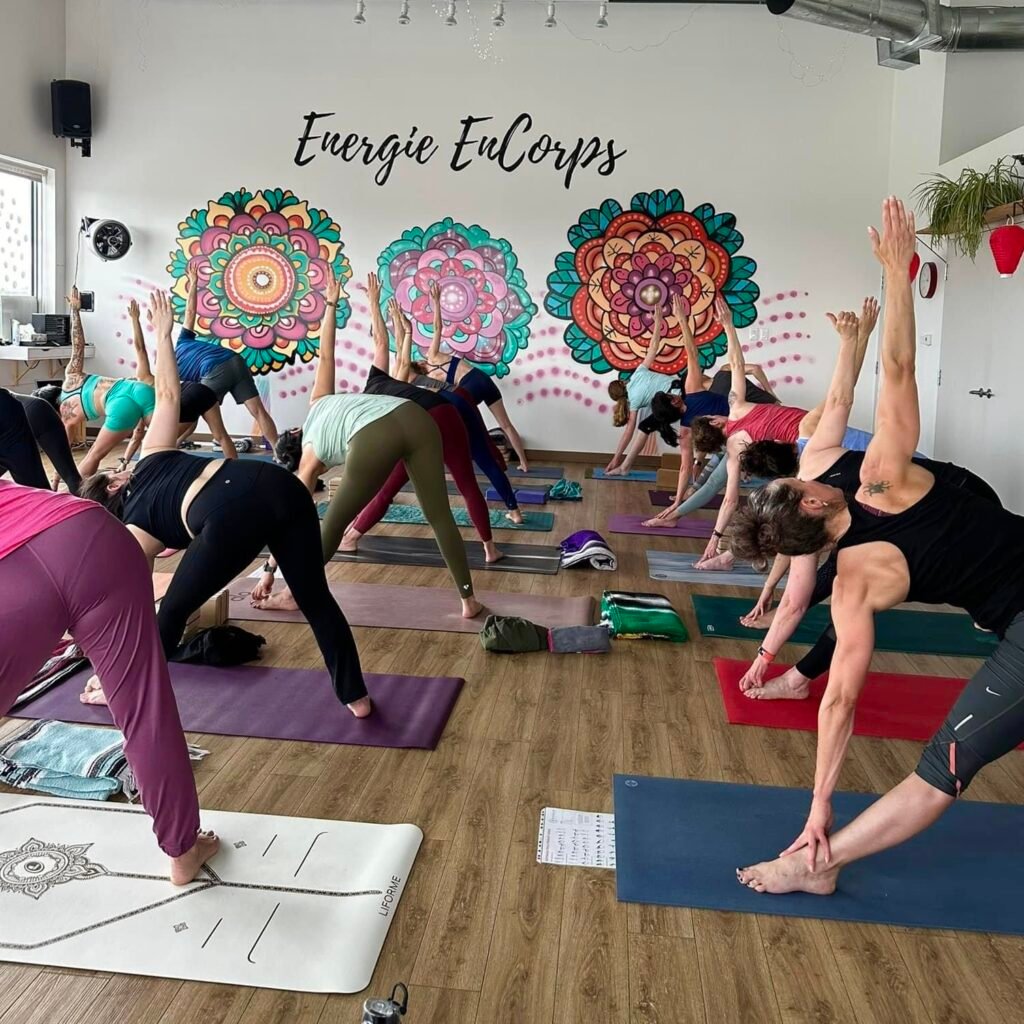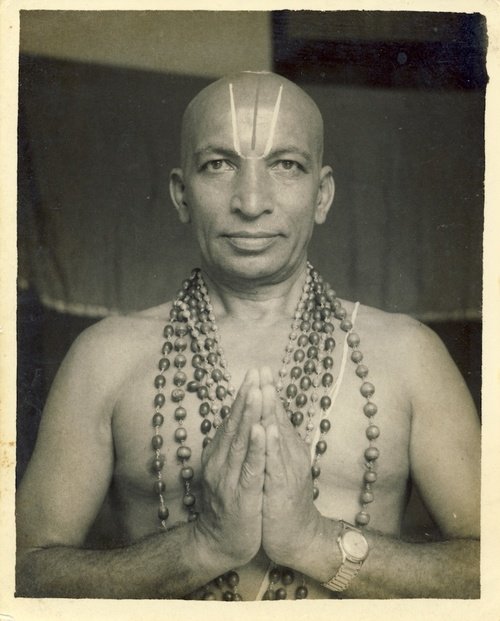What is Ashtanga Yoga?
The heart of our yoga practice
Ashtanga Yoga is for everyone
First things first: Ashtanga Yoga is a practice accessible to all bodies, ages, and abilities. At Energie EnCorps, our goal is to share this inclusive practice with you. Ashtanga encompasses not just physical postures but also breathwork and meditation, allowing you to engage with the philosophy and tradition behind it. We introduce you to an entirely new world, including Sanskrit counts, chants, and the names of postures. We are excited to share our passion and this whole new world with you.

Ashtanga Yoga with us
At Energie EnCorps, our goal is to make Ashtanga Yoga accessible to all, regardless of age, experience, or body type. We believe everyone can benefit from learning to go inward, quiet the mind, and find balance through Ashtanga yoga.
Your practice may look different from what you see in books or online, but our aim is to help you find your own way to practice the teachings.
Our classes are heavily inspired by Ashtanga yoga. We offer traditional Mysore and Led Primary Series classes, as well as shortform classes that adapt the tradition to focus on different aspects and levels. We emphasize Breath, Bandha, and Drishti, teaching you to breathe, use your body as a tool, and focus.
We are dedicated to teaching not just the physical practice, but also the philosophy and tradition of Ashtanga yoga, enriching your journey on and off the mat.
Interested in learning more? Visit us! Check out our classes, workshops, and teacher trainings! Get to know us!
Our Ashtanga Journey...
We are part of the international Ashtanga sangha.
Ashtanga yoga thrives on its rich tradition, with teachings passed down through generations—a process known as Parampara. This tradition fosters a global community dedicated to personal growth and balance. Our lead instructor, Rozel Gonzales, embarked on her journey over 20 years ago with her first teacher, Mark Darby. Continuing her studies, she learned from Manju Jois, son of the renowned Pattabhi Jois, before meeting Kino MacGregor, who she considers her primary teacher today.
Rozel is committed to continuous education and travels to see her teacher twice a year. She enjoys traveling to connect with other Ashtanga practitioners and teachers, enriching her practice and ability to share this knowledge with her own local students. She is dedicated to developing and building the Ashtanga community here in Montreal by passing on the teachings and hosting the Ashtanga community’s most respected teachers.
History of Ashtanga Yoga

Tradition is the foundation on which good yoga practice is built.
Ashtanga yoga is a practice whose goal is to balance the body and the mind, using postures and breath as tools for alignment inside and out. It is a practice of personal development, self-awareness and self-realization. In essence, the practice shows you the way to journey inwards, to get to know oneself better and to help you be the best version of yourself possible.
Ashtanga yoga is so much more than just postures; it requires years of practice and study of both the postures and the philosophy and tradition. This method of practice is what we strive to teach at Energie EnCorps. Our style of teaching aims to be accessible to all ages, abilities, levels and body types. All of our teachers at Energie EnCorps have studies the traditional methods and whether or not you are taking a Mysore, Ashtanga Primary series class or even one of our EnergieFLO classes, all of our classes at the studio are rooted in the Ashtanga tradition.
Deeply rooted in tradition and community, Ashtanga yoga originated from the teachings of T. Krishnamacharya, a prominent yoga teacher in the early 20th century. The modern form of Ashtanga yoga was developed and popularized by his student, Sri K. Pattabhi Jois, who studied under Krishnamacharya at the Mysore Palace in India, where this practice was refined and systematized. Traditional Ashtanga yoga is the foundation for many modern yoga styles, influencing a wide range of practices today.
The Ashtanga community values the tradition of teacher-student transmission, with Jois’s family, particularly his grandson Sharath Jois, continuing to teach and maintain the practice at the Shri K. Pattabhi Jois Ashtanga Yoga Institute (KPJAYI) in Mysore.
Tradition is the foundation on which good yoga practice is built.
If you are reading this, it means that you have either had the good fortune to discover the practice of Asthanga yoga, you are curious or you have the opportunity to learn. Not everyone has the chance to practice with a teacher, have a shala to frequent or to be part of a sangha… a community. You are blessed. Practice with us!
Building the Montreal Ashtanga Yoga Community
An Ashtanga yoga community takes years to build. It is a true labor of love—one that requires a dedicated teacher and committed students to grow, learn, overcome challenges, and get stronger together. The development of the West Island Montreal Ashtanga community has been our passion and ongoing project since 2015.
Over the years, our founder Rozel Gonzales has continued to deepen her own Ashtanga yoga practice—learning directly from her teachers, traveling to study abroad, refining her skills as a teacher, and always remaining a devoted student and practitioner.
Each year, international Ashtanga teachers are invited to our Montreal yoga studio to share their wisdom and inspire our community. We’ve had the honor of hosting world-renowned teachers such as Kino MacGregor, Tim Feldmann, Marque Garaux, and soon Joseph Armstrong and Edgar Navarro.
At Energie EnCorps in Montreal, we are proud to welcome these incredible teachers and to nurture a space where the Ashtanga yoga tradition continues to thrive. May this lineage live on through our shared passion and dedicated practice. And may we make this practice accessible to all, expanding the circle of people with whom we share its wisdom and light.
FAQs on Ashtanga Yoga
Practicing Ashtanga Yoga can improve physical strength, flexibility, and endurance. It also promotes mental clarity, focus, and a sense of inner peace. Regular practice can enhance overall well-being and balance.
No, Ashtanga Yoga is suitable for all levels. Beginners can start with the basics and gradually progress through the series. Modifications and guidance are provided to accommodate all practitioners. The best class to learn Ashtanga yoga is in our Mysore classes where a teacher would be able to work one-on-one with a teacher.
A typical Ashtanga class involves a set sequence of poses that are performed in a specific order. Classes often start with a series of Sun Salutations, followed by standing, seated, and finishing postures. The practice is usually accompanied by specific breathing techniques.
It is important to consult with a healthcare professional before starting any new exercise regimen, including Ashtanga Yoga. Inform your instructor about any injuries or health conditions so they can provide appropriate modifications and guidance. Depending on your situation, it may be best to begin with a few private classes prior to joining a group setting. Please consult with our staff to help you choose the right class.
In Mysore-style classes, students practice the Ashtanga sequence at their own pace with individualized guidance from the instructor. This is the traditional way to teach Ashtanga. Led classes involve the instructor leading the group through the sequence together, offering verbal cues and adjustments.
